Here’s the Influential Woman in History Who Has Your Myers-Briggs® Personality Type
Have you ever wondered which famous and inspiring woman in history has your personality type? Back when I was a kid (way back in the ’80s and ’90s), I used to love perusing the biography section of the library. My favorite person to research was George Washington Carver, but after that I bulldozed my way through biographies of Harriet Tubman, Helen Keller, and Anne Frank.
Exploring the biographies of people who’ve come before us can inspire us to do great things and to dream big! In today’s article we’ll only scratch the surface of what these women accomplished. I hope you’ll be inspired to head to your local library and discover more about these women and go after your own ambitions and dreams.
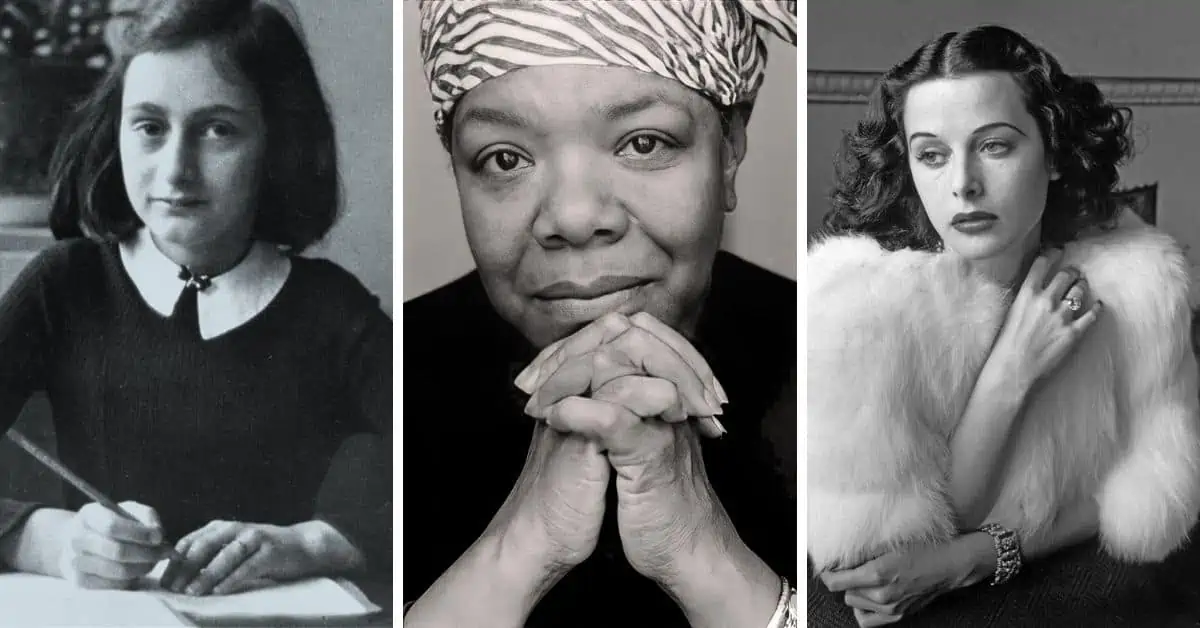
Not sure what your personality type is? Take our new personality questionnaire here. Or you can take the official MBTI® here.
Table of contents
- Here’s the Famous Woman in History who Has Your Myers-Briggs® Personality Type
- The ENFP – Anne Frank
- The ENTP – Catherine the Great
- The INFP – Harriet Tubman
- The INTP – Chien-Shiung Wu
- The ENFJ – Maya Angelou
- The ENTJ – Queen Elizabeth I
- The INFJ – Jane Addams
- The INTJ – Jane Austen
- The ESFP – Sappho
- The ESTP – Helen Gibson
- The ISFP – Frida Kahlo
- The ISTP – Hedy Lamarr
- The ESFJ – Dolley Madison
- The ESTJ – Ann Preston
- The ISFJ – Mother Teresa
- The ISTJ – Queen Elizabeth II
- What Are Your Thoughts?
Estimated reading time: 28 minutes
Here’s the Famous Woman in History who Has Your Myers-Briggs® Personality Type
The ENFP – Anne Frank
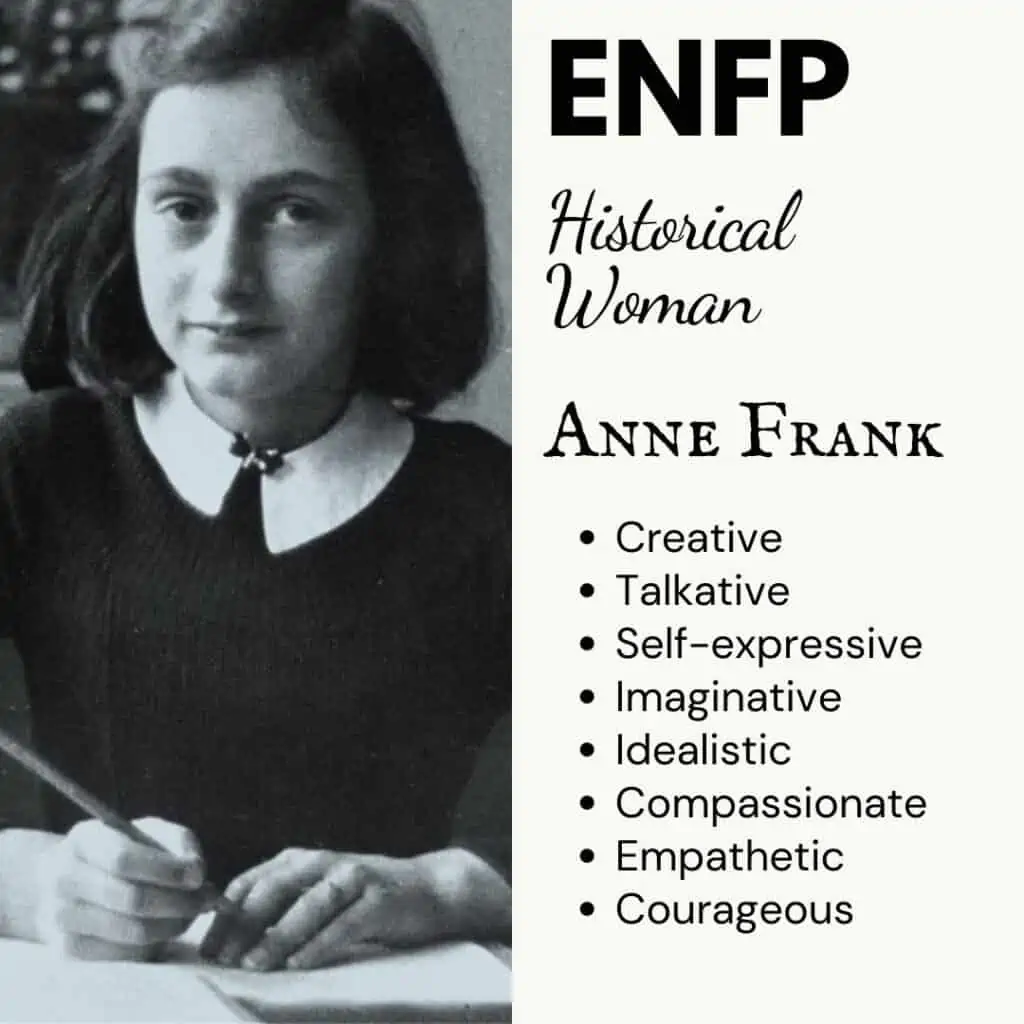
“How wonderful it is that nobody need wait a single moment before starting to improve the world.” – Anne Frank
Idealistic and inspiring, Anne Frank refused to give up on the goodness of people. Even though she faced some of the worst humanity has to offer, she maintained hope that people could change. Before the Nazi occupation, Anne Frank was an outgoing, vivacious girl who loved to write. She also loved Greek mythology, cats, movie stars, and boys! Known for being talkative, she was made to write several essays on the subject of “A Chatterbox” in school. Like many ENFPs, Anne needed an outlet for the overflowing ideas and stories in her head.
When the Frank family went into hiding, Anne’s world was turned upside down. She was forced to give up her friends, school, and any sense of normalcy or freedom. Later, when she was taken to the concentration camp, she was separated from her family and faced starvation, sickness, and the constant threat of death. Even in the face of these horrific conditions, Anne maintained hope. In her diary she wrote:
“I keep my ideals, because in spite of everything I still believe that people are really good at heart.”
Throughout this turmoil, Anne found solace in writing. She poured her heart out in her diary, documenting not only the events of daily life but also her hopes, dreams, and fears. She also used her diary as a way to work out her own identity and to process the confusing events going on around her. Anne’s diary has become one of the most widely read books in the world and continues to inspire people of all ages with its message of hope. ENFPs will relate to Anne’s passion for writing, her love of people, and her indomitable hope.
Read This Next: Dealing with Emotional Overwhelm as an ENFP
The ENTP – Catherine the Great
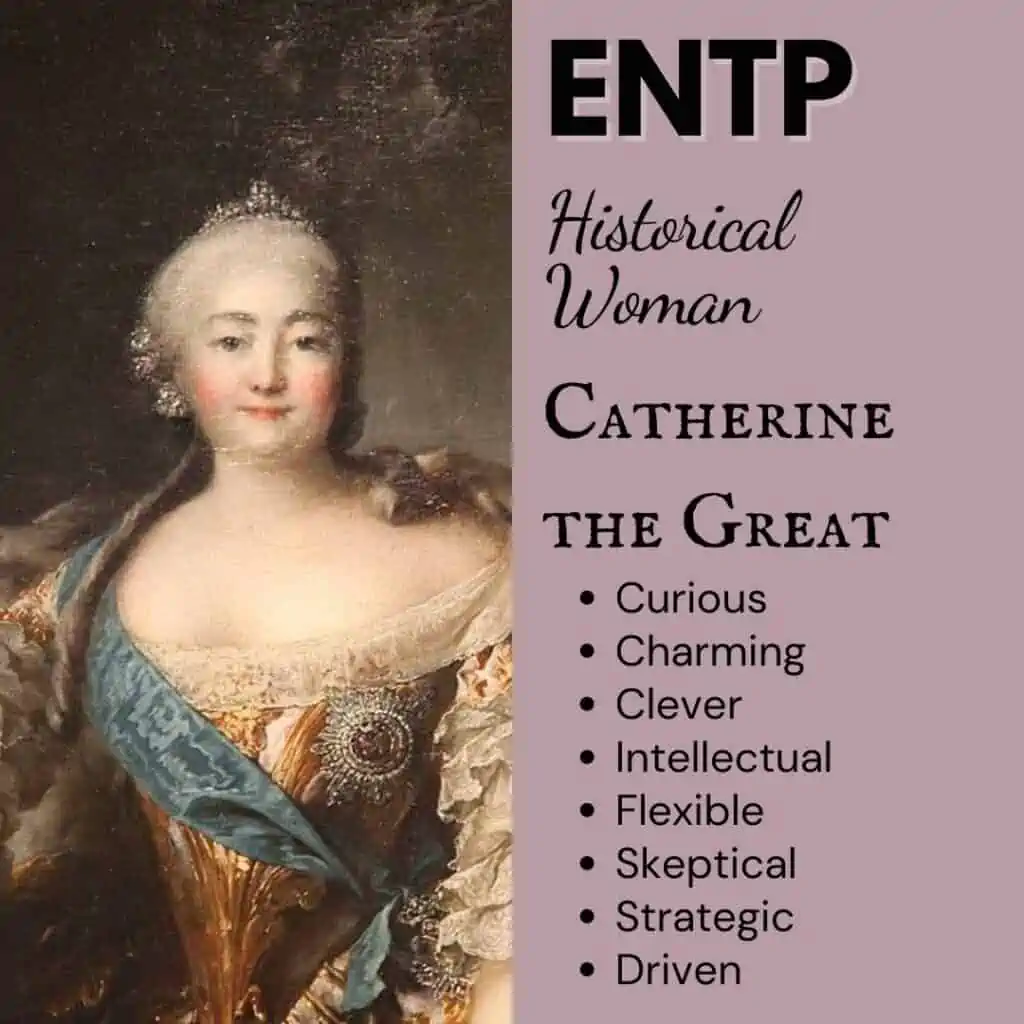
“I am one of the people who love the why of things.” – Catherine the Great
Catherine the Great was one of the most influential rulers in history. She came to power in a coup, going so far as to oust her own husband in order to take the throne. As empress, she oversaw a period of incredible expansion and modernization for Russia. Like most ENTPs, her mind was bursting with ideas and possibilities, and she couldn’t wait to put them into action!
Before taking the throne, Catherine was a highly intelligent but sheltered young woman. When she was brought to Russia to marry the future emperor, she had a lot to adjust to. Russia was a very different world than the German principality she came from and she didn’t speak the language! Yet like most ENTPs, Catherine was flexible and ready for a challenge. She quickly learned Russian and went on to become one of the most educated women of her time. Reading voraciously kept her active mind occupied, and she eventually amassed one of the largest book collections in the world! She was also a keen patron of the arts and sciences and corresponded with some of the most brilliant minds of her day.
Catherine’s thirst for knowledge led her to implement many educational reforms during her reign. A tireless worker, she strived to reduce serfdom, promote religious toleration, and expand the rights of women. When she wasn’t working hard to make changes, she enjoyed horseback riding, hunting, and spending time with her many friends and lovers. While she knew how to work hard, she also knew how to play hard! She was known for her charm, humor, and wit, and developed many admirers as a result.
ENTPs will appreciate Catherine’s curiosity, ambition, and intelligence. They will also admire her willingness to go against convention and make waves in order to bring about positive change.
Read This Next: A Look at the ENTP Leader
The INFP – Harriet Tubman
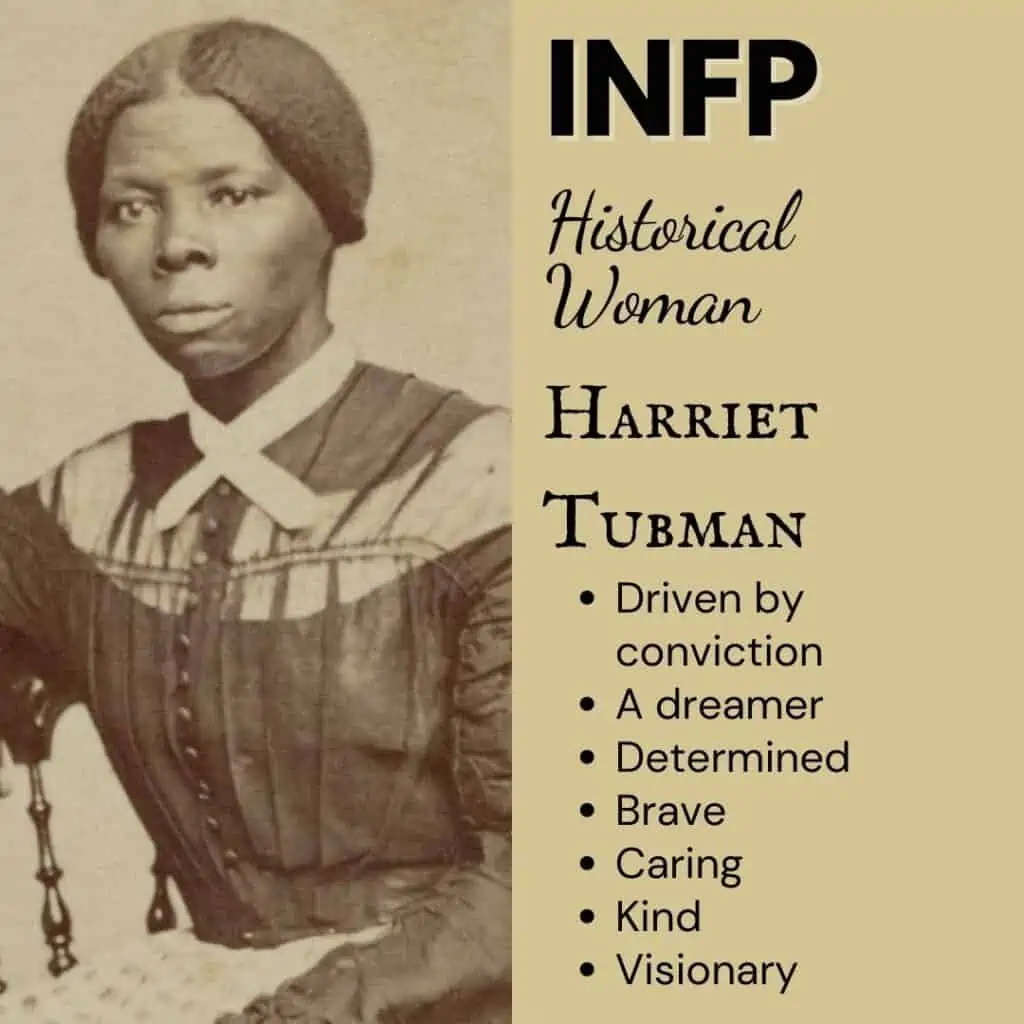
“Every great dream begins with a dreamer. Always remember, you have within you the strength, the patience, and the passion to reach for the stars to change the world.” – Harriet Tubman
Harriet Tubman was an abolitionist and Underground Railroad conductor who helped hundreds of slaves escape to freedom. Born into slavery in 1822, she experienced a violent and tragic childhood where she was regularly beaten and mistreated. Yet through all the oppression, she still maintained her sense of self and her courage. This showed up as early as age 12, when she intervened to keep her owner from beating an enslaved man who tried to escape. Her owner threw a two-pound weight at her head which fractured her skull. Afterwards, she was forced to continue her work without any medical attention. Sadly, she suffered a lifetime of severe headaches and narcolepsy as a result. While these experiences were harrowing, they never stopped her determination and ideals.
In 1849, Harriet Tubman managed to escape from the South. While she could have enjoyed her freedom, she instead made the decision to go back and help others achieve the same freedom she had found. Her stubbornness was unmatched, and she would go so far as to point a gun at runaway slaves who wanted to turn back. Her fearlessness in the face of danger was inspiring to those who felt anxious and afraid for their lives.
While Harriet Tubman was a fierce protector and helper of slaves, she was also a dreamer. She had visionary experiences from a young age, which she believed were messages from God. These experiences would guide her on her journey to freedom and later inspire her work as an abolitionist. There were many times when it would have been easier for Harriet to be comfortable in her freedom and enjoy her life without fear of danger. But instead, she kept turning back, again and again, to venture into the South and bring other slaves to freedom.
When Harriet finally did embrace freedom, she continued to find ways to help others. One of Harriet’s great dreams was to grow apple trees and give the fruit to anyone who needed it. After she settled in Auburn, New York, she bought some land and planted an apple orchard which others could eat from freely. She also started a home for the elderly, which would eventually become known as Harriet Tubman Home.
INFPs will be inspired by Harriet’s unwavering dedication to her cause and her belief in the power of dreams. They will also appreciate her selfless nature and ability to do what’s right rather than what was comfortable or easy.
Read This Next: 24 Signs That You’re an INFP, the Dreamer Personality Type
The INTP – Chien-Shiung Wu
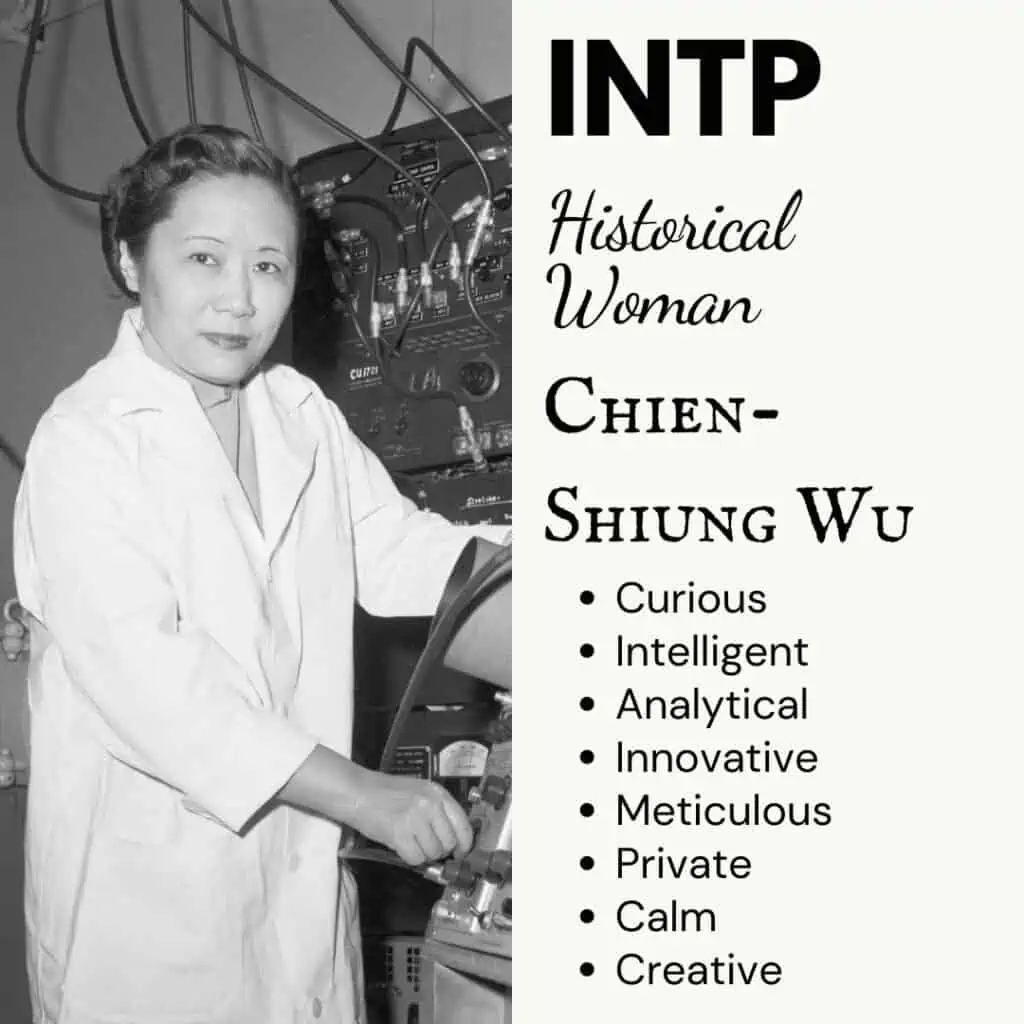
“There is only one thing worse than coming home from the lab to a sink full of dirty dishes, and that is not going to the lab at all!” – Chien-Shiung Wu
Chien-Shiung Wu was one of the most distinguished experimental scientists of the 20th century. She made significant contributions to the field of radioactivity and paved the way for other women in science. Wu was born in China but came to the United States to study physics at the University of California at Berkeley. She went on to teach at Princeton, even though she faced discrimination as a woman and as an Asian. Like many INTPs, Chien-Shiung Wu was private and meticulous, preferring to keep to herself or dialogue with other innovative researchers.
In 1956, Wu and her colleagues conducted an experiment which disproved the law of conservation of parity. This discovery was considered one of the most important physics breakthroughs of the 20th century. Wu’s work was largely unrecognized at the time, because she was not given credit for her role in the experiment. Instead, her male colleagues were awarded the Nobel Prize in Physics in 1957. It is often believed that Wu was not given credit for her work because of sexism and racism.
Despite the injustices she faced, Wu continued to work hard and make significant contributions to the field of physics. All her efforts resulted in her winning the National Academy of Sciences Cyrus B. Comstock Award in Physics in 1964, the National Medal of Science in 1975, and the Wolf Prize in Physics in 1978.
But science wasn’t just about awards for Chien-Shiung Wu. She wanted to make a difference for women in science. She enjoyed creating educational programs or girls in the STEM fields and was a vocal advocate for increasing the participation of women in physics and engineering.
INTPs will admire Chien-Shiung’s intelligence, curiosity, and willingness to challenge the status quo. Many will also relate to her meticulousness with experimentation. She wasn’t afraid to stay behind the scenes if it meant that her work would be accurately represented.
Read This Next: 24 Signs That You’re an INTP, the Prodigy Personality Type
The ENFJ – Maya Angelou
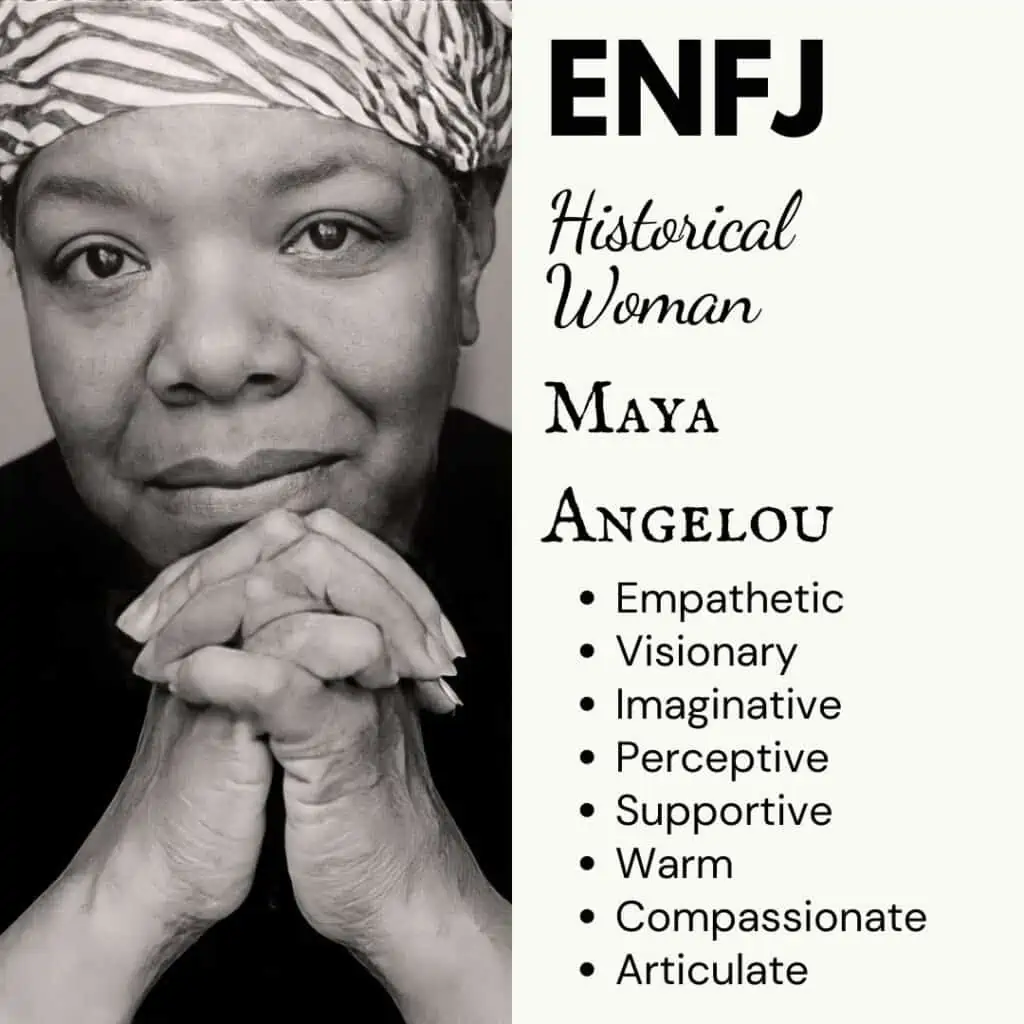
“I like for people to say I’m kind. It means that I’m still learning and that I’m able to forgive.” – Maya Angelou
Maya Angelou was a world-renowned poet, author, and civil rights activist. She is best known for her series of autobiographies, which detail her early life experiences growing up in the American South during the 1930s and 1940s. Angelou was born into a family of poverty and faced racism and sexual abuse throughout her childhood, but she still managed faced the world with kindness and generosity. Although she struggled with anxiety disorders and belittlement by others, she never gave up on herself or on people. Her warm smile and insightful presence made her a natural influencer, and she used her platform to fight for the rights of African Americans.
Angelou’s most famous work was her autobiography, I Know Why the Caged Bird Sings. The book was published in 1969 and details Angelou’s childhood experiences with racism, sexual abuse, and poverty. Despite the difficult subject matter, the book was a huge success and is still considered one of the most important autobiographies of all time. On top of her writing, Angelou was an active civil rights campaigner. She worked closely with Martin Luther King Jr. and was even given the title of Northern Coordinator for the Southern Christian Leadership Conference.
ENFJs will be inspired by Maya Angelou’s resilience in the face of adversity and her commitment to using her platform to make a difference in the world. They will also appreciate her warmth, compassion, and vision. Her bold and passionate way of living demonstrate the resilience of the human spirit, which is something that ENFJs are hugely inspired by.
Read This Next: Inspiring Morning Routines for INFJs, INFPs, ENFJs, and ENFPs
The ENTJ – Queen Elizabeth I
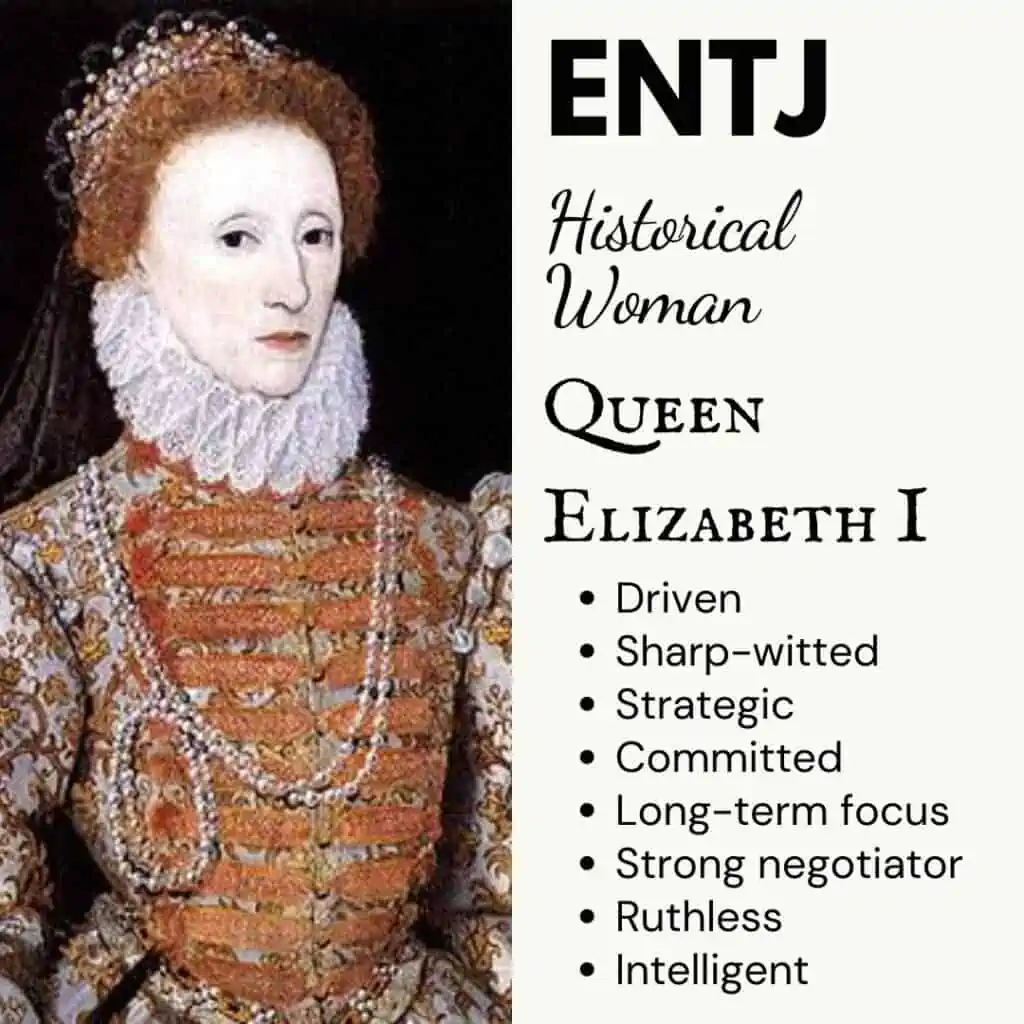
“I know I have the body but of a weak and feeble woman, but I have the heart and stomach of a king, and of a king of England too.” – Queen Elizabeth I
Queen Elizabeth I is one of the most well-known monarchs in history. She ruled over England for 45 years, during a time when the country was engaged in religious conflict and economic turmoil. Elizabeth was a skilled politician and a master of public relations, and was noted for her strong personality and sharp wit. Like many ENTJs, she could speak her mind, and she knew how to do it strategically.
Elizabeth’s reign is often considered to be one of the most successful in English history. She restored economic stability to the country and increased its international standing. She also helped to end the country’s religious conflicts by founding the Church of England. While she was a controversial figure in her own time, and she continues to be controversial today, she was certainly ambitious and visionary. Some people view her as one of the greatest monarchs in history, while others believe that she was a tyrannical ruler who caused great harm to her subjects.
ENTJs will admire Queen Elizabeth I’s intelligence, strength of character, and political acumen. They will also appreciate her ability to make difficult decisions and her commitment to her country. Elizabeth was a true visionary and a natural leader, which are qualities that ENTJs can relate to.
Read This Next: 10 Things You’ll Relate to if You’re an ENTJ
The INFJ – Jane Addams
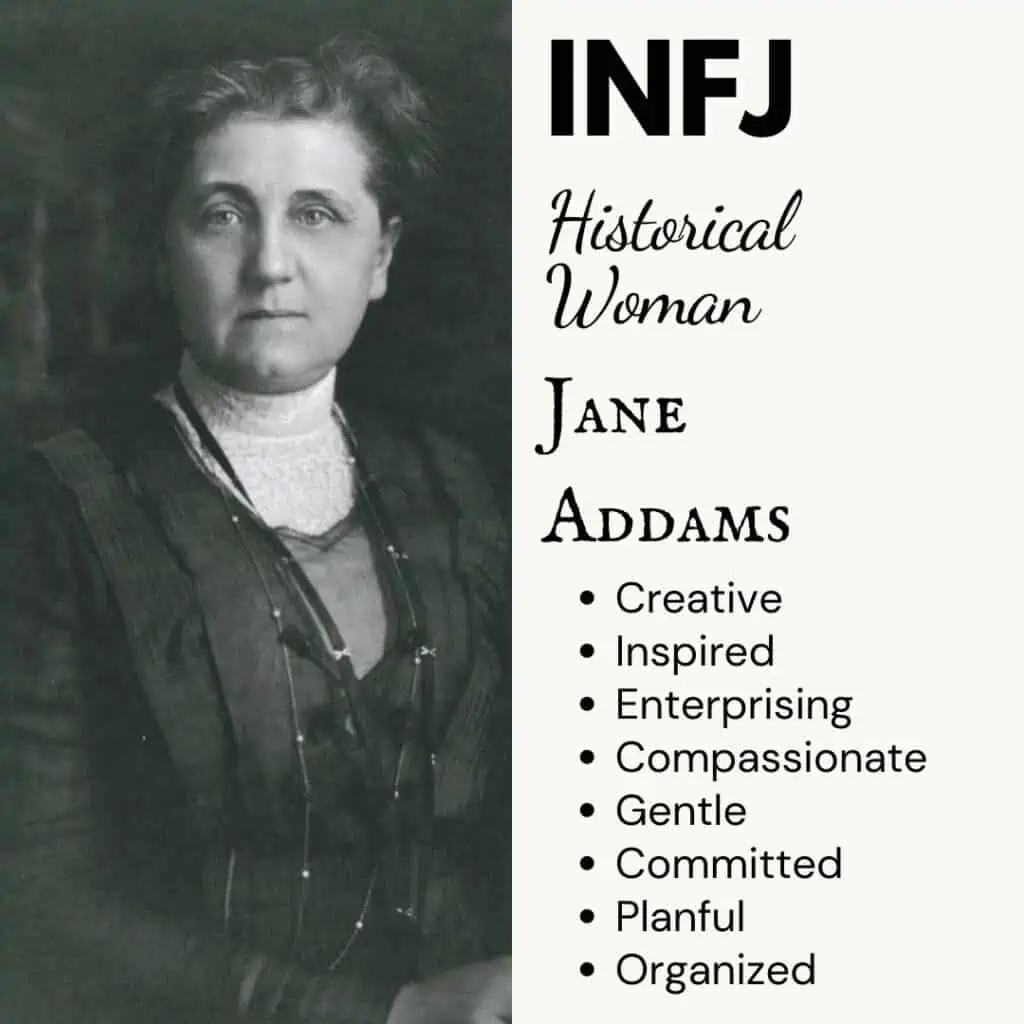
“Nothing can be worse than the fear that one had given up too soon and left one unexpended effort which might have saved the world.” ― Jane Addams
Jane Addams was a social reformer, activist, and writer who was driven to make the world a better place for women, outsiders, and the needy. Compassionate and visionary, she worked tirelessly to improve the lives of immigrants and working-class people in urban areas. Through the creation of “Hull House,” she was able to provide social services, education, and cultural opportunities to the people of Chicago’s immigrant community.
Among her many charitable efforts, Addams was also a prolific writer and thinker. She wrote extensively on topics such as democracy, social justice, and international relations. Driven by her ideals and desire for a better world, she advocated for justice for immigrants and African Americans. And it wasn’t enough to take action, she also wanted to get to the root of society’s prejudices and societal corruption. She worked to advocate research into the causes of poverty and crime and helped people to see the interconnectedness of all social ills.
Addams once said, “The good we secure for ourselves is precarious and uncertain until it is secured for all of us and incorporated into our common life.” She showed that these words of hers were tied to action on her part, and were not simply a platitude.
INFJs will be inspired by Jane Addams’s passion for social justice and her tireless dedication to helping others. They will also appreciate her intelligence, insight, and vision. Addams was a true idealist who believed in the power of people to change the world. Her life is a testimony to the fact that one person can make a difference.
Read This Next: 4 Reasons You Might Be Lonely as an INFJ
The INTJ – Jane Austen
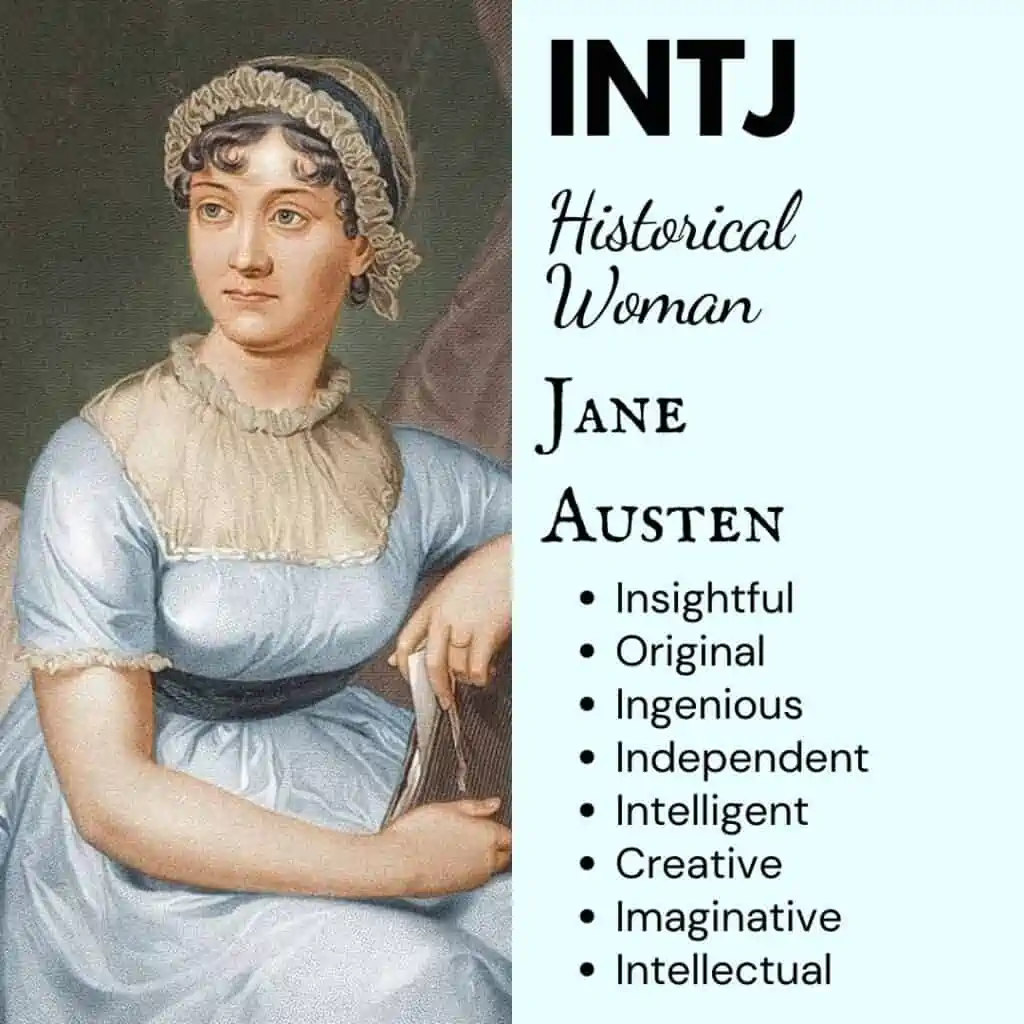
“There is a stubbornness about me that never can bear to be frightened at the will of others. My courage always rises at every attempt to intimidate me.” – Jane Austen
Jane Austen was a renowned English novelist who is best known for her novels of regency and romance. She was a master of irony and satire, and her work is known for its wit and sharp social commentary. Austen’s novels have been popular since they were first published, and they continue to be much loved by readers today.
Like many INTJs, Austen was a private person, who preferred to live a quiet life in the country. Despite her introverted nature, she was a gifted writer with a sharp mind. She used her fiction to explore the social issues of her day, and to challenge the expectations placed on women. Unlike many women of her time, she had no desire to marry and be at the beck and call of a husband. Austen was content to live a life of the mind, and she did so with great success.
In the words of her protagonist Emma, “A woman is not to marry a man merely because she is asked, or because he is attached to her, and can write a tolerable letter.”
Austen’s novels are known for their insight into human nature, and her ability to capture the nuances of social interactions. INTJs will appreciate her keen intellect and her ability to see beyond the superficial. They will also identify with her independent spirit and her disdain for conformity.
Read This Next: 24 Signs That You’re an INTJ, the Strategist Personality Type
The ESFP – Sappho
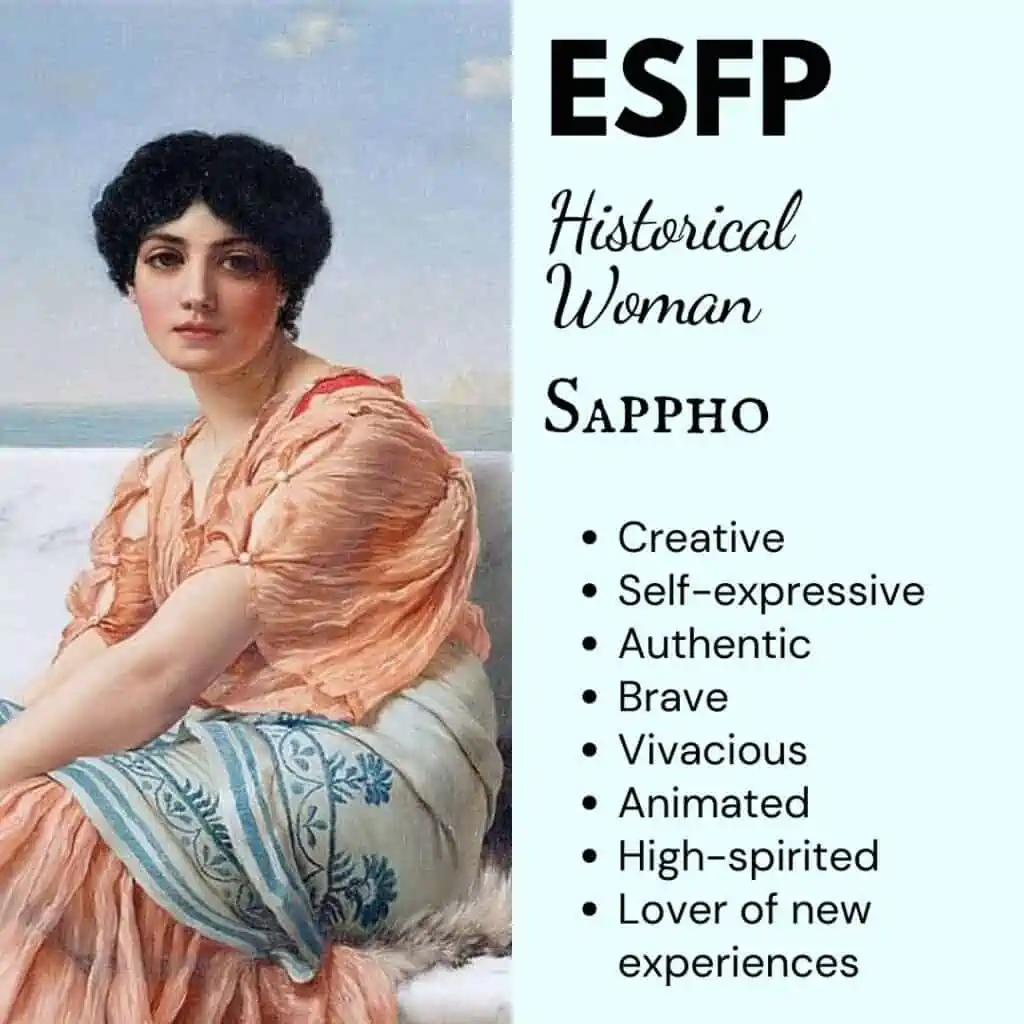
“Once again love drives me on, that loosener of limbs, bittersweet creature against which nothing can be done.” – Sappho
Sappho was a Greek poetess, who lived on the island of Lesbos in the 6th century BCE. She is known for her lyrical poetry, which was often about love and desire. Sappho’s work was hugely influential in ancient Greece, and she was revered by later poets such as Aristotle, Plato, and Socrates. Like many ESFPs, Sappho was driven to express her innermost feelings in a creative way. She wrote in such a way that you felt the feelings of emotions in your body and soul; the nuances of the physical feelings of love, desire, or even grief were powerfully created by her pen.
Although little is known about her life, Sappho’s poetry gives us a window into her mind. She was a passionate and emotionally sensitive woman who was not afraid to express her desires and her vulnerability. Her frankness about love and sex was shocking in her day, but it was one of the things that made her work so timeless. She was also known for having strong social skills and influence, communicating with people from all walks of life.
ESFPs will identify with Sappho’s passion for life and her desire for connection. They will also appreciate her courage in speaking her truth, even when it was not popular. Sappho was a woman who lived life on her own terms, and she is an inspiration to all who seek to do the same.
Read This Next: 10 Things ESFPs Look for in a Relationship
The ESTP – Helen Gibson
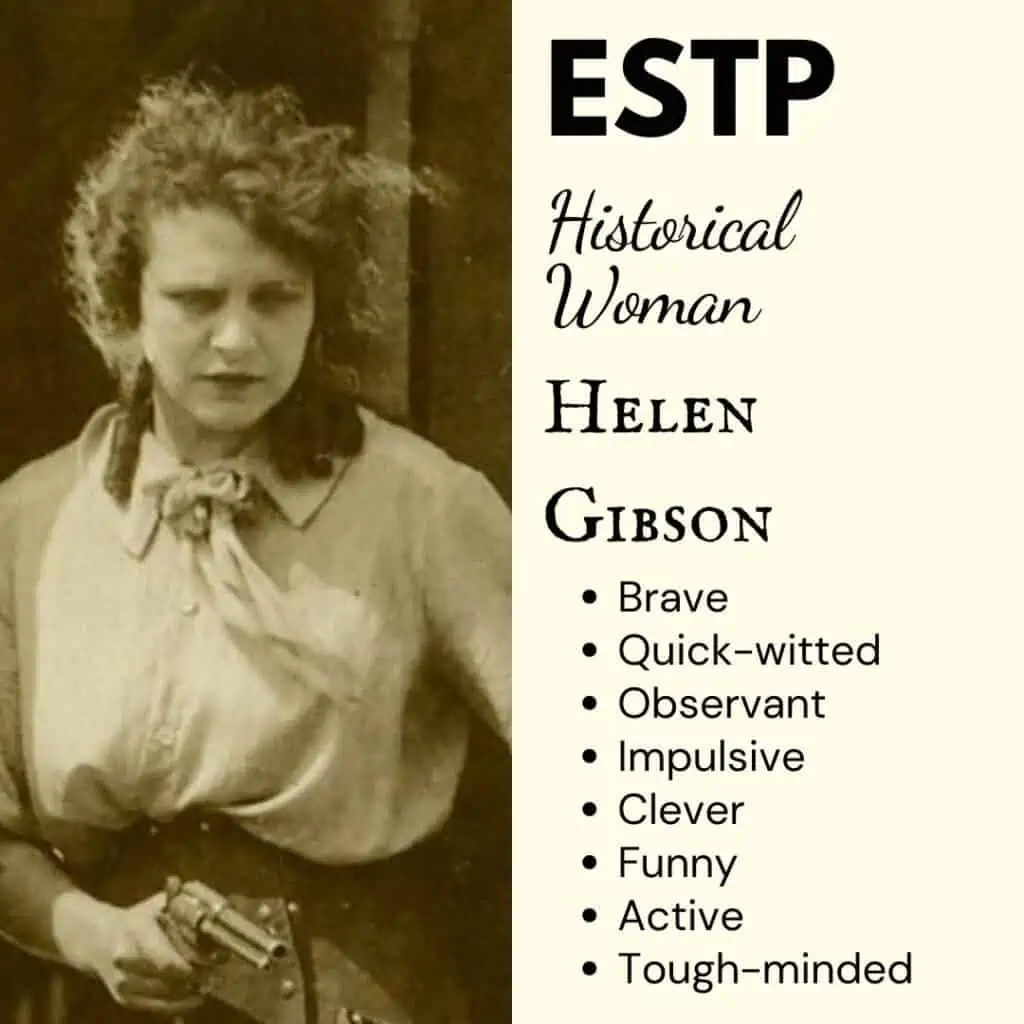
“I have heard that they call me ‘The Girl with Nine Lives.’ Well, if the description is right, I am pretty certain that I have lost eight of the nine already, for it is a rather weird coincidence that in my career as the ‘hazardous Helen’ there have been just eight occasions when I really did come within a fraction of an inch of losing my life. But I am not afraid; I am just going to keep on carrying out the actions of thrilling scenarios. Only I hope the ninth extra narrow escape is a long, long way off.” – Helen Gibson
Helen Gibson was the first female stuntwoman in Hollywood, and she quickly became known for her death-defying feats and quick wits. She was a gifted athlete and fearless daredevil, who performed stunts that no other woman had dared to attempt. From an early age, Gibson was determined to live life on her own terms. She was a trailblazer in her field, and she paved the way for other women to follow in her footsteps. She said of her childhood,
“(I) was already practicing picking up a handkerchief from the ground at full gallop. When veteran riders told me I could get kicked in the head, I paid no heed. Such things might happen to others, but could never happen to me, I believed. We barnstormed all over the US and the season ended all too soon. I was sorry when I had to go home, and could hardly wait to open in Boston in the spring of 1911.”
In typical ESTP fashion, Gibson was pragmatic and logical. When she married her first husband, Edmund Richard (Hoot) Gibson, it was because she saw the potential for a good partnership and a way for both of them to earn more money. She was not interested in being a traditional wife and homemaker; she wanted an equal partner who would support her career and who could have fun with her!
Gibson was known for her humor, wit, and her ability to think on her feet. She was always ready with a quip or a come-back, and she was not afraid to speak her mind. She was a woman ahead of her time, and she is an inspiration to all who seek to live life on their own terms.
Read This Next: 10 Reasons Why ESTPs Make Amazing Friends
The ISFP – Frida Kahlo
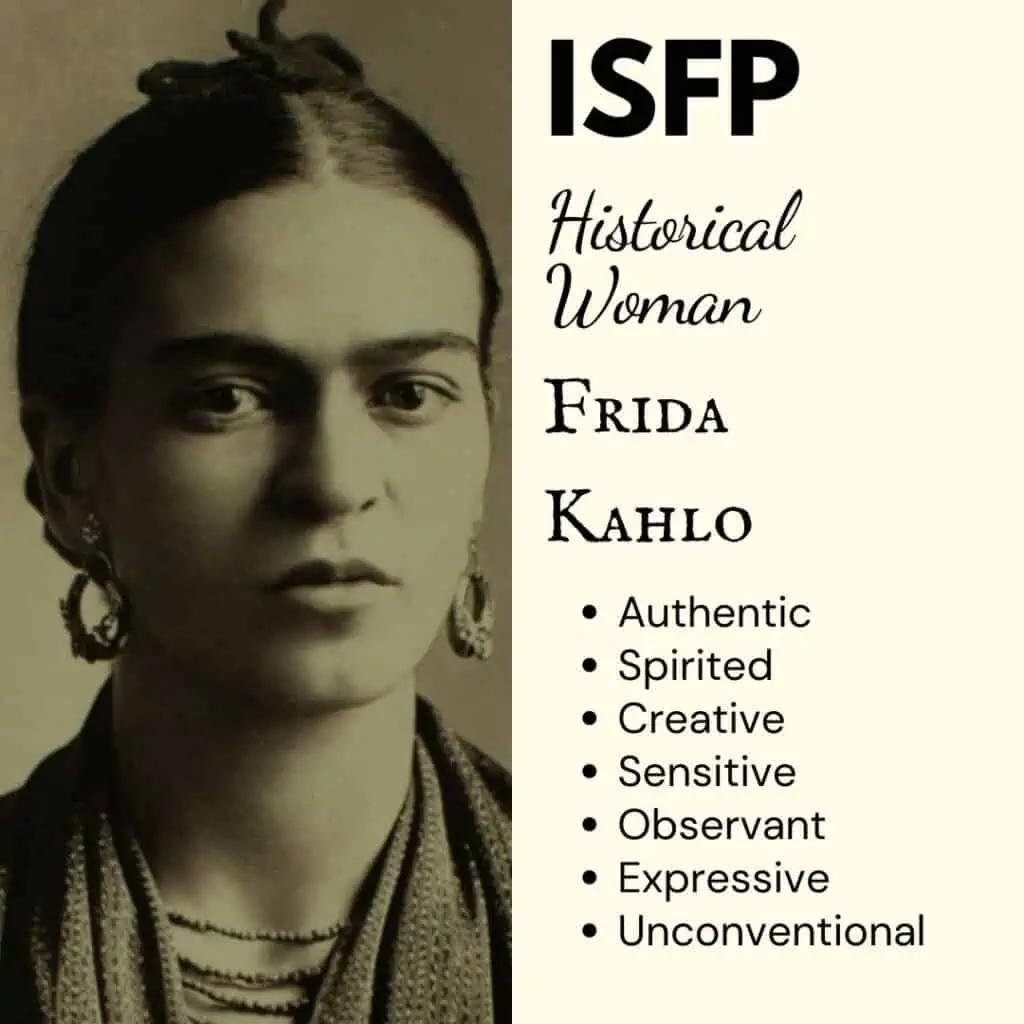
“I paint myself because I am so often alone and because I am the subject I know best.” – Frida Kahlo
Frida Kahlo was a Mexican artist, who is best known for her self-portraits and symbolic creations. Unfortunately, Kahlo’s life was far from easy. As a child she was stricken with polio and ever after had to struggle to walk with a right leg and foot that were much smaller than her left. However, that didn’t stop her from challenging herself physically and creatively. When recounting her childhood, she spoke of her involvement in soccer, swimming, and even wrestling! But it was art that truly had Frida’s heart. Her intensely vivid and symbolic paintings reveal a deeply personal side of her. In them, she often explored themes such as illness, death, and heartbreak. Her miscarriages, her failed relationships, and her struggles with mental health are all recurring themes in her work.
Despite the pain that Kahlo often depicted in her paintings, she was known for being a lively and vibrant person. She was passionate about her art, and she had a strong sense of self. She was also known for being fiercely independent, and she didn’t let anyone or anything stand in her way.
Kahlo was an ISFP, and she is a perfect example of the type. She was in touch with her emotions, and she used her art as a way to express herself. She was also independent and determined, following her own path regardless of what others may have thought.
Read This Next: 24 Signs That You’re an ISFP, the Virtuoso Personality Type
The ISTP – Hedy Lamarr
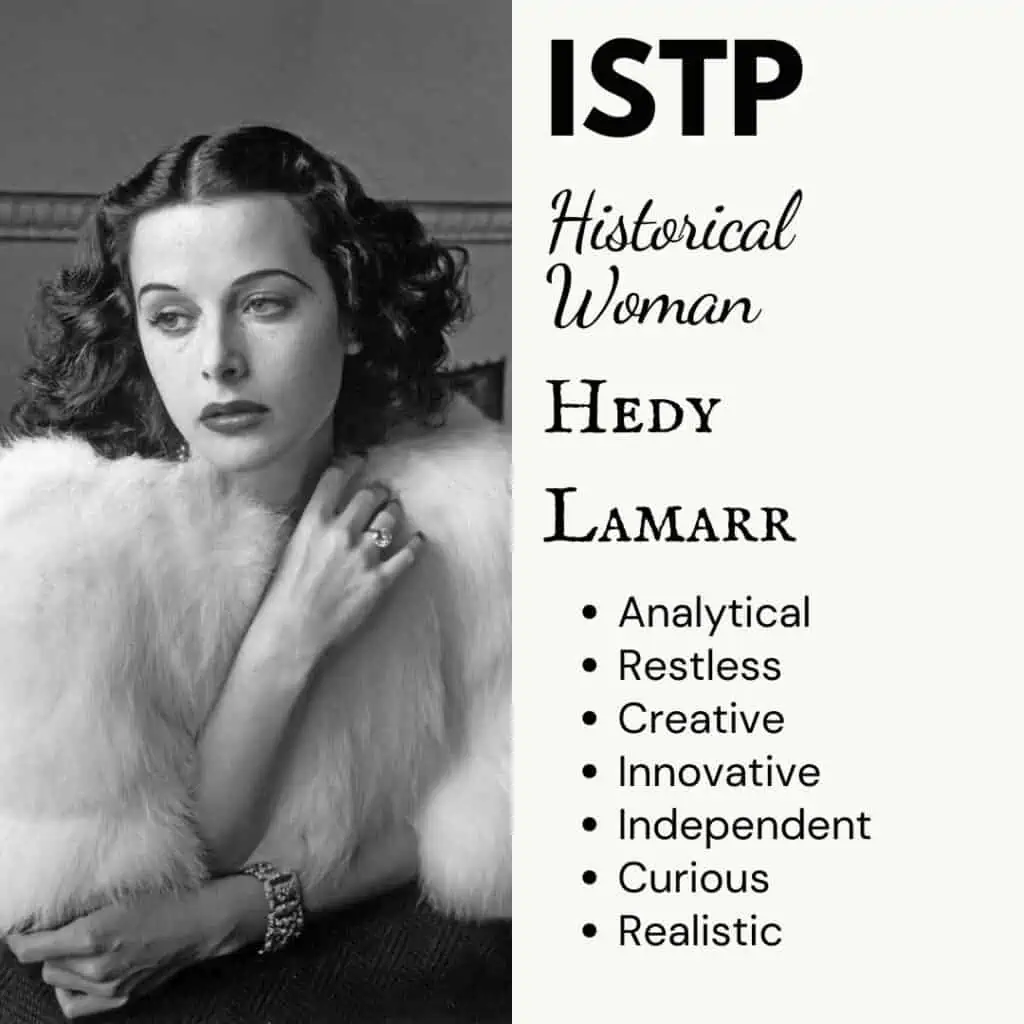
“Any girl can be glamorous. All you have to do is stand still and look stupid.” – Hedy Lamarr
Hedy Lamarr was a Hollywood actress known for her beauty and acting chops. But what few people know is that Lamarr was also a brilliant inventor. She developed a frequency-hopping signal that was used during World War II to help the Allies defeat the Nazis. She also held a patent for a technology that became the basis for modern WiFi, Bluetooth, and GPS systems.
Lamarr’s interest in inventing started at a young age! At only five-years-old, she could be found taking apart and reassembling her music box to figure out how the machine worked. Like most ISTPs, she was interested in how various systems worked and how different technologies operated. Her scientific mind was soon noticed in Hollywood by none other than legendary inventor, Howard Hughes. Hughes helped fuel her innovative mind and she, in turn, designed a new wing shape that that made his planes more aerodynamic.
Unfortunately, Hedy often felt underwhelmed by her partnerships in Hollywood and in Marriage. She once said, “I must quit marrying men who feel inferior to me. Somewhere there must be a man who could be my husband and not feel inferior.” Her curiosity, intellect, and need for independence didn’t always go hand-in-hand with the traditional views of women and Hollywood starlets in her day.
ISTPs will find in Lamarr a kindred spirit – someone who is interested in the world around them and how things work. They will also appreciate her independent streak and her willingness to forge her own path, even when it was not the common or traditional thing to do in her time.
Read This Next: 10 Things You Should Never Say to an ISTP
The ESFJ – Dolley Madison
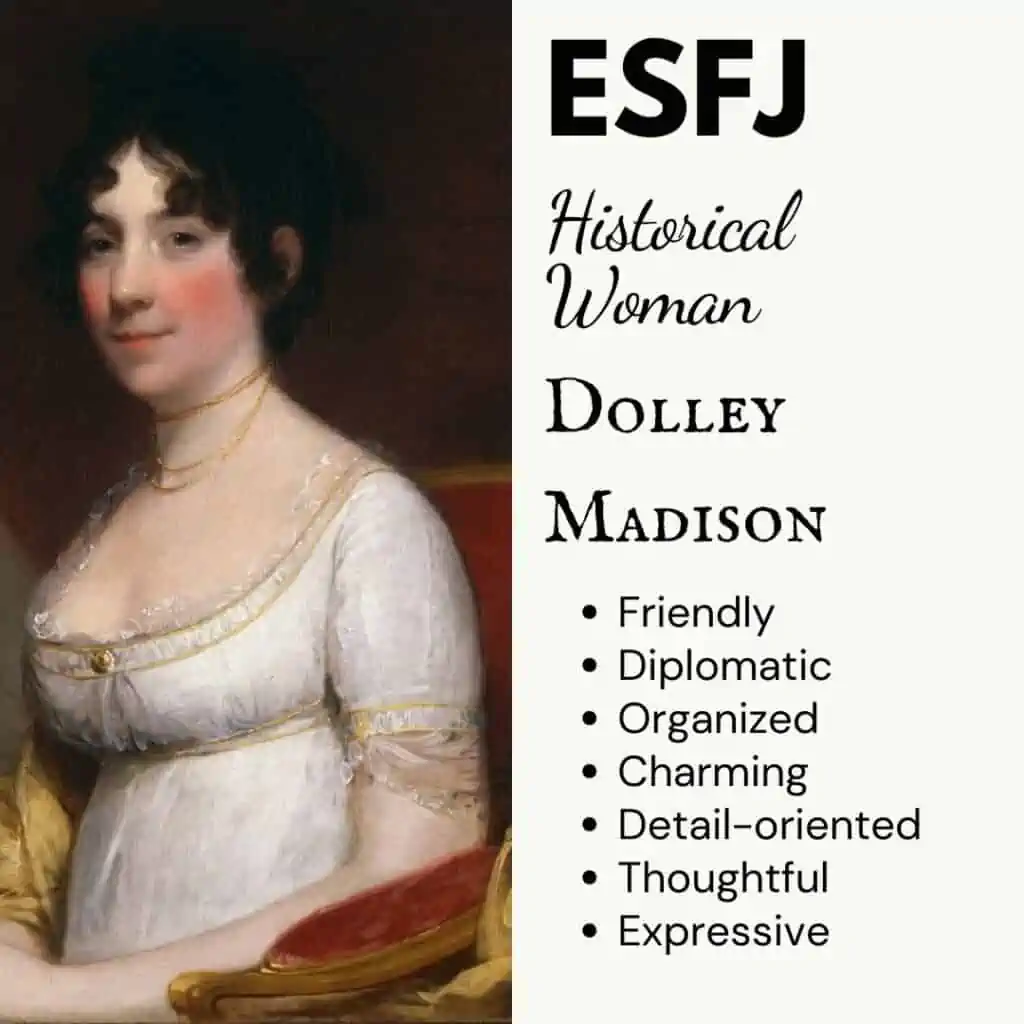
“She welcomed all classes of people, greasy boots and silk stockings.” – Senator Elijah Mills
Dolley Madison was the wife of President James Madison, and she is considered to be one of the most popular First Ladies in American history. She was known for her kindness, her warmth, and her ability to make everyone feel welcome. A lover of fashion, people, and parties, she knew how to make the White House an inviting and cordial place.
Dolley’s skills weren’t only relegated to parties and fashion, however. She was gifted in the art of diplomacy and was often called upon by her husband to help him resolve conflicts. As an example, when President Madison dismissed his secretary of state, Robert Smith, she invited him to dinner to make sure there were no ongoing hard feelings. When he refused her invitation, she called on him personally. According to some historians, when many Americans complained that Madison had led them into an unnecessary war, she used her invitation lists to win him favor and a second term.
Dolley, like many ESFJs, was also someone who valued aesthetics and elegant living. She oversaw the furnishings and decorations of the White House and established the tradition that the mansion would reflect every First Lady’s tastes and ideas.
In Dolley ESFJs will find a First Lady who was kind, hard-working, and relatable. They will also see someone who used her skills to build relationships and foster goodwill. Her attention to detail and her focus on interpersonal relationships and harmony are qualities that ESFJs will naturally aspire to.
Read This Next: 10 Stress-Busting Tips for ESFJs
The ESTJ – Ann Preston
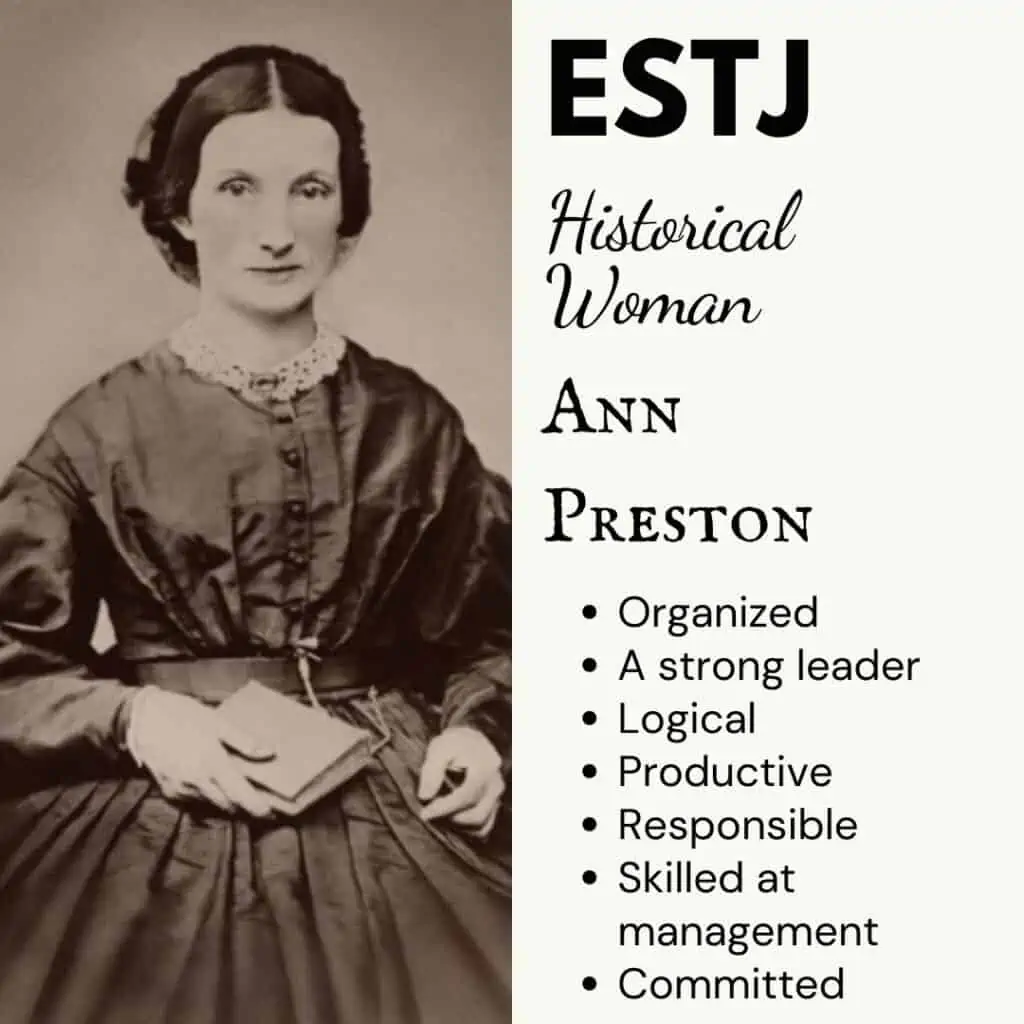
“Wherever it is proper to introduce women as patients, there also it is in accordance with the instinct of truest womanhood for women to appear as physicians and students.” – Ann Preston
Ann Preston was a Quaker physician and educator who fought for the inclusion of women in medical schools and the medical profession. In a time when most women were not allowed to attend medical school, she graduated at the top of her class from Female Medical College of Pennsylvania.
Life for Ann wasn’t easy, and she often met opposition when she tried to campaign for the rights of women. When she worked to make it possible for women to attend clinical lectures, she was often faced with “booing” and jeering from the men attending. Yet these outbursts never dissuaded her in her mission. She knew opening up the medical field to women would change the world and make it a better place.
Like most ESTJs, Ann was a responsible and driven person. In childhood she often took care of her family and seven siblings due to her mother’s frequent illnesses. She was also highly organized, serving as the first female dean of the Female Medical College of Pennsylvania.
Ann’s drive and determination is something that ESTJs will relate to. They will also appreciate her organizational skills and her ability to take charge when needed. Ann was known as being highly organized but also social and inviting. While she never married, she led a rich and active social life, and formed a household “where dear friends live with me in harmonious relations, and do much to make this an orderly home circle.”
The ISFJ – Mother Teresa

“Kind words can be short and easy to speak, but their echoes are truly endless.” – Mother Teresa
Mother Teresa is one of the 20th centuries greatest humanitarians and a powerful example of generosity and faithfulness. Born as Agnes Gonxha Bojaxhiu in Macedonia, she was given an extraordinary example of charity by her mother, Drana Bojaxiu. Agnes’s mother believed that every meal should be shared with others, and would open her home to the poor and destitute so that people could find acceptance and nurturing for their body and soul. When young Agnes asked her mother who the other people were at the table, her mother would respond, “Some of them are our relations, but all of them are our people.”
Agnes took her mother’s charitable perspective to heart and decided to devote her life to helping others as well. At age 12 she started her religious education, and in 1929 she took her final vows and was given the name Teresa, after Saint Thérèse of Lisieux. In 1937, she took her Final Profession of Vows to live a life of poverty, chastity, and obedience. Upon taking the vows, she was given the title of “Mother” and became known thereon as Mother Teresa. “Give me the strength to be ever the light of their lives, so that I may lead them at last to you,” she wrote in a prayer about her service to others during this time.
In 1946, a pivotal moment set Mother Teresa on the course that would make her world-renowned. While riding a train from Calcutta to the Himalayan foothills for her annual retreat, she received “a call within a call” from God telling her to leave the comfort of the convent and go out into the streets to help the poorest of the poor. And so she did. Afterwards, she spent the rest of her life living among and helping some of the most destitute people in India.
Whether Mother Teresa was establishing a home for the dying or creating open-air schools, she did everything with an attitude of service. She was selfless, compassionate, and always put the needs of others above her own. These qualities are what healthy ISFJs are often known for. Cautious and uncomfortable with change, Mother Teresa nevertheless accepted risks and change because she had to follow her faith and what her heart told her was right. Her altruistic, empathetic outlook on life are examples that people of any personality type can aspire to.
Read This Next: A Look at the ISFJ Leader
The ISTJ – Queen Elizabeth II
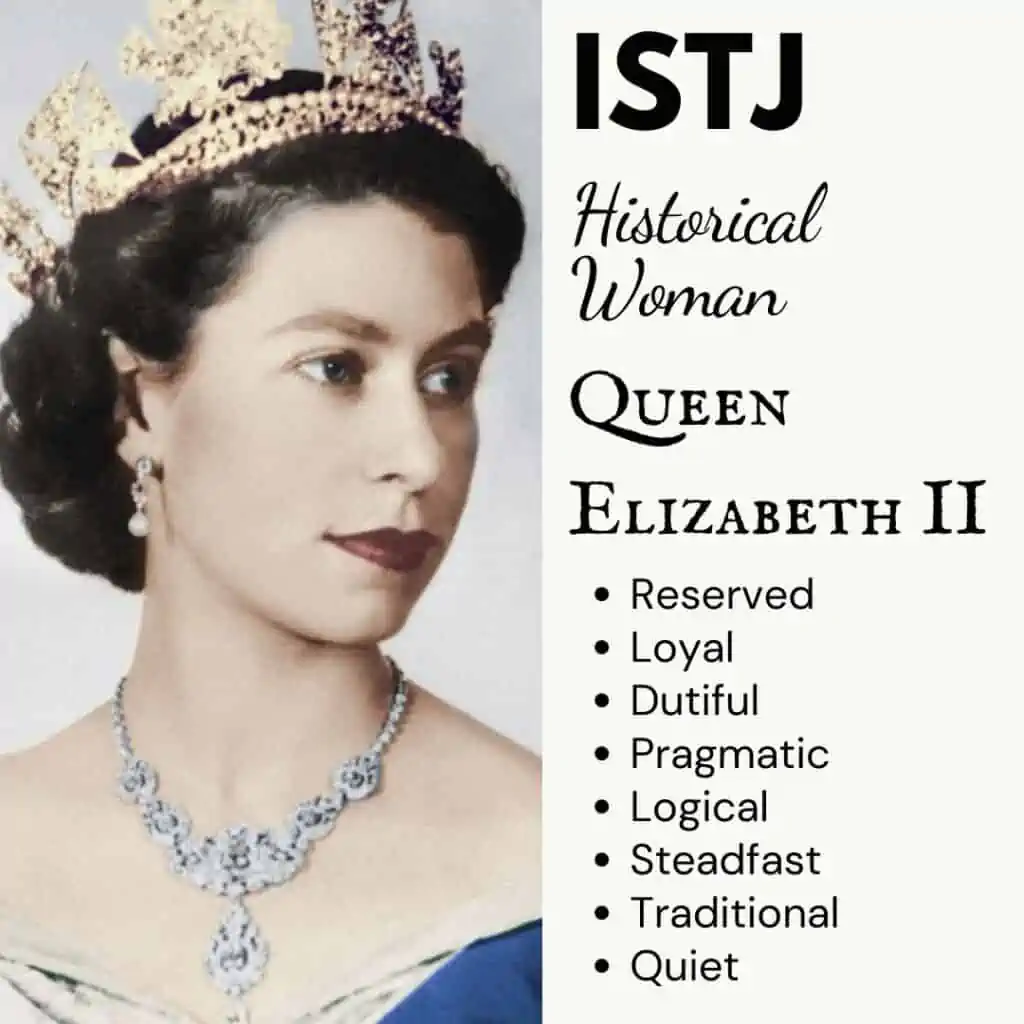
“It’s worth remembering that it is often the small steps, not the giant leaps, that bring about the most lasting change.” – Queen Elizabeth II
A picture of grace under pressure, Queen Elizabeth II has ruled over the United Kingdom and Commonwealth for over 65 years. Born in 1926 to Prince Albert, Duke of York, and Elizabeth Bowes-Lyon, Elizabeth became heir presumptive to the throne when her father unexpectedly became King George VI following the abdication of his brother Edward VIII.
While the Crown has certainly had its critics, nobody can deny that Queen Elizabeth II has worked hard to be a faithful and just ruler. She has been consistent in her duties, even when they’ve been difficult, and has always put the needs of her subjects first. This is obvious when one looks at her current schedule! Even as she passed her 90th birthday, she continued to make more than 400 engagements a year and has managed to support hundreds of charitable organizations and programs.
Cautious and practical, Elizabeth is not someone who takes unnecessary risks. She prefers to stick to tradition and the tried-and-true methods that have worked in the past. However, she isn’t stuck on inefficient methods. If something isn’t working, she is willing to adapt and try something new. This balance of conservatism and progressivism has served her – and her country – well during her long reign.
While many people talk about Queen Elizabeth’s formal, tough-as-nails demeanor, those who know her closely also speak of her humor. Canadian politician Michael Ignatieff remarked in 2010, after spending time with the Queen, how he was surprised by her “wonderful sense of the absurd” and noted her “sense of humour, that sense of the absurd, that sense of comedy of life has survived 60 years of gruelling public life.”
As an MBTI® practitioner, I can’t tell you the dozens of times I’ve heard people reference ISTJ humor and how offbeat and surprisingly quirky it is. While they can often seem serious and no-nonsense, when they finally do have time to relax, they enjoy letting loose with an odd joke or uncanny observation. ISTJs are also known for being dutiful, detail-oriented, and pragmatic. Like Queen Elizabeth II, they appreciate rules and traditions, as long as they don’t get in the way of their conscience or efficiency.
Read This Next: 5 Strengths of the ISTJ Personality Type
What Are Your Thoughts?
Do you agree with these type assessments of these famous women in history? Let us know in the comments below!
Find out more about your personality type in our eBooks, Discovering You: Unlocking the Power of Personality Type, The INFJ – Understanding the Mystic, The INTJ – Understanding the Strategist, and The INFP – Understanding the Dreamer. You can also connect with me via Facebook, Instagram, or Twitter!














That’s so funny. I’m an ISFP, and I actually have a Frida Cahlo necklace
Please can you do a piece on biblical characters personality type for females or both genders
Yes please! That would be amazing
Wonderful post, I enjoyed reading the subscriptions and learning about these amazing women.
Wow, I am a INFJ and a clinical social worker. I’m not surprised Jane Adams the mother of social work is the woman representing INFJs
Mother Theresa did serious harm to people. She told people their suffering was their own doing/they deserved it. She with held care for people who she thought needed to suffer as penance.
Not someone I’m happy to be compared to.
I’ve noticed you’ve used the word intelligent and it’s synonyms for T types only. It’s a bit puzzling to me because I’m surrounded by bright feelers. Could you please shed some light on this? Thanks.
Hi Yegi! There are so many intelligent Feeling types. I went over this article just now to check if I’d only used that word with Thinking types, because I certainly didn’t want to imply that only Thinking types could be intelligent. It looks like I used the word ‘intelligence’ four times; for ENTPs, INFJs, ENTJs, INTPs. But as I was re-reading my descriptions I think you can tell that intelligence is implied among all these types because of the incredible impact each one had on the world. I may have used other words ‘insightful’, ‘visionary’, or even simply reading through what each woman achieved in their life is a testament to how truly smart each of these types can be. If you want more insight into my thoughts on type and intelligence, I’ve written quite a few articles on that. I’m posting them below if you’re interested:
https://www.psychologyjunkie.com/the-unique-intelligence-of-each-myers-briggs-personality-type/
https://www.psychologyjunkie.com/the-unique-intelligence-of-the-istj-isfj-estj-and-esfj-personality-types/
https://www.psychologyjunkie.com/the-unique-intelligence-of-infjs-intjs-enfjs-and-entjs/
https://www.psychologyjunkie.com/the-unique-intelligence-of-esfps-estps-isfps-and-istps/
https://www.psychologyjunkie.com/the-unique-intelligence-of-enfps-entps-infps-and-intps/